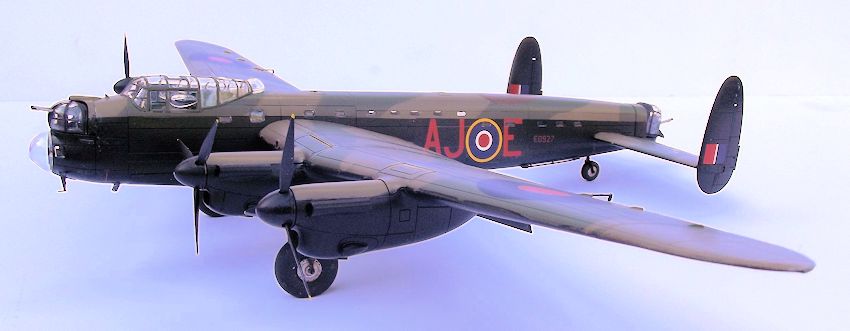
Airfix 1/72 Lancaster B.III (special)
| KIT #: | A09007 |
| PRICE: | £29.99 SRP ($42.99 in the US) |
| DECALS: | Two options |
| REVIEWER: | Frank Reynolds |
| NOTES: | New tool kit |

| HISTORY |
Avro Lancaster. A legend. Borne out
of necessity by a redesign of the unsuccessful twin-engine Avro Manchester, the
Lancaster was recognised as a primary tool of the Royal Air Force in prosecuting
a strategic bombing campaign against Nazi Germany between March 1942 and May
1945. It was good but imperfect; of some 7300 built nearly half were lost in
action; its defensive armament was considered poor to pathetic by the standards
of the day and its underside was cruelly vulnerable to night fighter attack. Its
undoubted assets were a long range, surprising agility for such a large machine
and an unusually large and uncluttered weapons bay that was adaptable to a wide
range of weapons. Its interior was dark and cramped and passage down the length
of the fuselage was hampered by the intrusive bulk of the wing sp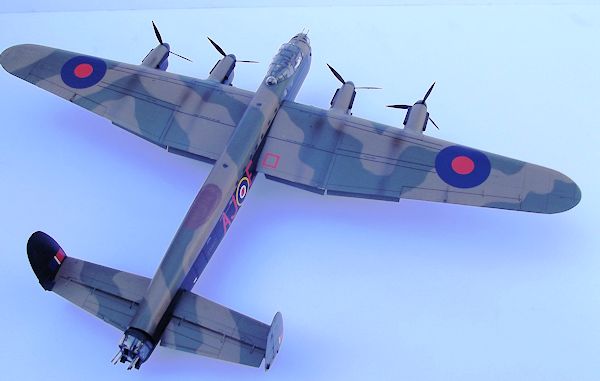 ar.
Powered by four reliable Merlin engines the Lancaster was altered relatively
little during its four-year production cycle but detail differences between
sub-variants make it an interesting challenge for the researcher and modeller.
Mk.I airframes are essentially an all-British affair with Rolls Royce engines,
Mk IIIs are powered by the US-built Packard Merlin.
ar.
Powered by four reliable Merlin engines the Lancaster was altered relatively
little during its four-year production cycle but detail differences between
sub-variants make it an interesting challenge for the researcher and modeller.
Mk.I airframes are essentially an all-British affair with Rolls Royce engines,
Mk IIIs are powered by the US-built Packard Merlin.
Much of the legend of the Lancaster
was forged in one operation in the dark days of early 1943, when Britain was
slogging its way through the middle years of that awful conflict. The strategic
bombing campaign had yet to build any momentum and bombing accuracy was
questionable with a large percentage of bombs dropped missing their target by
hundreds of yards – in some cases by miles. Little wonder then,
that a
sensational attack on the Ruhr region dams in Germany’s industrial heartland
should go down in history as a momentous feat of arms. The legend was compounded
by the fact that the specialist 617 Squadron had formed at short notice, trained
in a matter of weeks, used a new and untried form of weapon and had flown in the
dark at ultra -low level over hostile territory to achieve their success.
19 Lancasters
were specially adapted for the raid with defensive armament stripped to a
minimum.
The cost to the
attackers was high. Of those 19 aircraft that set out from Scampton,
Lincolnshire on 16th May, only 11 would return in the early hours of the 17th.
The 8 losses represent 42% casualties, for 53 aircrew had perished and just 3
survived as POWs.
| THE KIT |
The Lancaster in 1:72 scale has been
a staple of kit manufacturers for decades. Airfix brought one to the marketplace
around 1960 and replaced that offering in 1990. The now defunct brands of Frog
and Matchbox took their turn in committing the legend to plastic. Revell brought
their version in the late 1960s and in turn provided a wholly new replacement to
21st century standards
a few years back.
Hasegawa, too have a competitive product to current standards, so it is no real
surprise that the newly resurgent Airfix should rise to the challenge of
providing a good quality Lancaster in this brand new moulding.
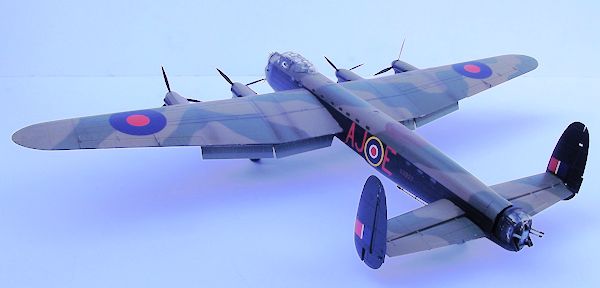 kit
contains a wide range of alternative parts applicable to a standard Lancaster
I/III none of which are applicable to the variant boxed. These include full size
bomb bay doors, early type needle blade propellers, unshrouded exhaust pipes,
mid upper turret and fairing, two-gun Rose-type tail turret, plain side windows
to the pilot canopy, shallow type bomb aiming blister, oval nose window. Absent,
however, are any bombs other than the special mine and the kit only provides the
shorter type astrodome to the rear of the main canopy.There is only one type of
tail wheel on offer, with a grooved tyre and some sources suggest that the 617
Sqn aircraft had the earlier type of smooth tyre.
kit
contains a wide range of alternative parts applicable to a standard Lancaster
I/III none of which are applicable to the variant boxed. These include full size
bomb bay doors, early type needle blade propellers, unshrouded exhaust pipes,
mid upper turret and fairing, two-gun Rose-type tail turret, plain side windows
to the pilot canopy, shallow type bomb aiming blister, oval nose window. Absent,
however, are any bombs other than the special mine and the kit only provides the
shorter type astrodome to the rear of the main canopy.There is only one type of
tail wheel on offer, with a grooved tyre and some sources suggest that the 617
Sqn aircraft had the earlier type of smooth tyre.
With this mass
of unused parts there is clearly much scope for more Lancasters to come from
these mouldings. This provides a generous harvest for the spares box, but since
Airfix is not inclined to include parts frames diagrams in their instructions
nor to identify parts “not for use”, a careful study of the instructions is
required. The instructions run to a 24-page A4 size book in black and white,
detailing no less than 110 constructional stages.
A separate 2
page full colour leaflet gives a choice of aircraft for Flight Lieutenant Joe
McCarthy, a US citizen in the Royal Canadian Air Force or that of Flight
Lieutenant Robert Barlow of the Royal Australian Air Force. I chose to model the
Barlow aircraft in tribute to the fact that he and his crew were among the
heroes who did not return from the raid.
The main wheel
tyres have a subtle flat moulded onto them. Neat touches abound throughout the
kit. The main undercarriage doors each have a steadying strut moulded on and
this simplifies alignment at the finishing stage. There is a tiny decal for the
navigator’s table forming a clearly identifiable map of North-West Europe.
This is a kit
that requires time and patience in the build working progressively from one
stage to another. There is some scope to build up sub-assemblies for those who
like to take that route.
| CONSTRUCTION |
Assembly begins with the interior,
using the long bomb bay roof as the fuselage floor and building up the flight
deck in the nose area. Good basic details are provided with the pilots’
instrument panel and throttles, internal bulkheads and tables for the navigator
and flight engineer. The crew seats are reasonably well detailed, but for some
reason the radio operator has no seat. The fuselage windows are provided as
clear strips, but I chose to omit these and install windows of Micro Kristal
Kleer at the
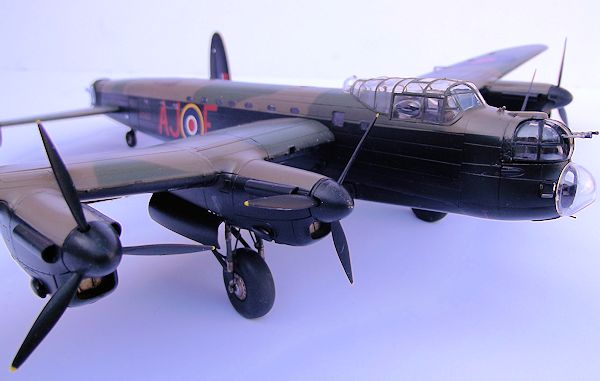 painting
stage. Two stout wing spars are fitted across the floor assembly at this stage.
Blanking plates are provided for the mid upper and ventral gun turret positions,
since this armament was omitted for most dams raid aircraft. The kit
nevertheless provides the single hand held belly gun that was fitted to
McCarthy’s aircraft. Much of the interior is the standard medium green of the
period, with the cockpit walls in night black. My current choice of finishes
come from Tamiya Acrylics using XF-71 IJN cockpit green and XF-1 black.
painting
stage. Two stout wing spars are fitted across the floor assembly at this stage.
Blanking plates are provided for the mid upper and ventral gun turret positions,
since this armament was omitted for most dams raid aircraft. The kit
nevertheless provides the single hand held belly gun that was fitted to
McCarthy’s aircraft. Much of the interior is the standard medium green of the
period, with the cockpit walls in night black. My current choice of finishes
come from Tamiya Acrylics using XF-71 IJN cockpit green and XF-1 black.
Closing up the
fuselage halves proved to be quite a chore, since my kit had quite the most
distorted fuselage halves I have found in years. The components are certainly
complex, featuring cut outs for the many windows, cockpit and turret openings
and bomb bay, but my samples must have left the mould too soon and were both
twisted and warped. It took a couple of days of progressive gluing and strapping
to get them to close up and a good deal of filler along the fuselage spine.
However having subsequently examined other kits at my LHS, I feel that I might
have just been unlucky. There are two prominent windows on the fuselage spine
that Airfix have omitted. They are shown as solid on the kit parts, so I drilled
them out, to be finished later with Kristal Kleer.
Attention now
turns to the wings and this concentrates the mind. The wheel wells are built up
with fore and aft ribs between the front and rear wing spars that poke out from
the fuselage centre section. Then the upper and lower wing halves are glued
together while trapping the spars and wheel wells inside. It works, and works
well but a clear head and plenty of dry runs will pay dividends. Next the
tailplane halves were added but I left the fins until much later since they
would be painted and added separately. The basic airframe was left for a couple
of days to harden, while the engine nacelles were built as separate assemblies –
a perfectly straightforward exercise and once everything had dried they simply
slip in place under the wings.
Now the awkward
part, for the main gear legs must be added next and will stick out and dangle
around for the whole of the rest of the build. Not my ideal, but I am not clever
enough to work my way around it.
 At this
stage I painted the main airframe in camouflage colours and most of the doors
and fairings that were still on the parts frames.
At this
stage I painted the main airframe in camouflage colours and most of the doors
and fairings that were still on the parts frames.
The whole
airframe was then propped upside down on the work bench while the underside was
detailed. The main gear assembles are well detailed and sturdily engineered. I
needed some reference to photographs to pick out the black legs with silver
detailing and I used a colour wash to dirty it up a little. Airfix offer dropped
wing flaps and I chose this option so that the green painted flap interior
provides some contrast against the black undersides. The modified bomb bay
proves the educational value of modelling since there is a small concealed
electric motor to spin the bomb and the small spotlights under the nose and bomb
bay that provided the crews with height measurements at ultra-low level.
The final
challenge came in masking off the gun turret transparencies, done by carefully
slicing Tamiya/Kabuki tape – necessary since I have not yet found any after
market masks for this new kit. The turret frames are clearly defined and their
interior frameworks have enough detail to be convincing to my eye. Then on with
the props., a few aerials, stand back and look.
| COLORS & MARKINGS |
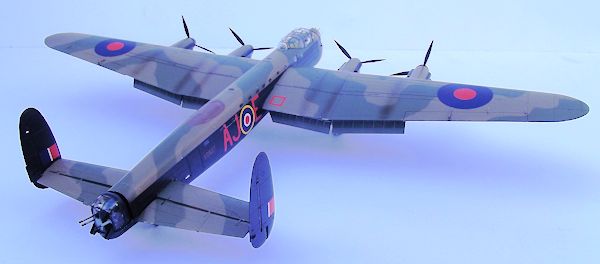 The Lanc.
was painted as follows: Dark Earth, Xtracrylix XA1002; Dark Green, Tamiya XF-81;
Black, Tamiya X-18 Semi Gloss Black; all flatted down with a coat of Xtracrlix
Matt varnish. The area on the fuselage spine, where the mid upper turret was
removed, was painted over in a noticeably different colour when the Lancasters
were modified for the Dams Raid. Arguments continue as to the exact colour but I
went for the school of thought that says it was a form of primer, so the area
was marked out in pencil using the redundant turret fairing as a pattern and
then hand painted in Tamiya XF-62 Red Brown.
The Lanc.
was painted as follows: Dark Earth, Xtracrylix XA1002; Dark Green, Tamiya XF-81;
Black, Tamiya X-18 Semi Gloss Black; all flatted down with a coat of Xtracrlix
Matt varnish. The area on the fuselage spine, where the mid upper turret was
removed, was painted over in a noticeably different colour when the Lancasters
were modified for the Dams Raid. Arguments continue as to the exact colour but I
went for the school of thought that says it was a form of primer, so the area
was marked out in pencil using the redundant turret fairing as a pattern and
then hand painted in Tamiya XF-62 Red Brown.
I used just a
hint of weathering by tracing the exhaust staining on the wings with a blow over
of Tamiya Smoke X-19. This should be subtle since the aircraft were virtually
new when issued to the squadron. There are only three exhaust trails over the
upper surface of each wing due to the effect of the dihedral on the outer wing
panel which causes the exhaust from the outboard side of the outboard engines to
pass straight under the wing.
| CONCLUSIONS |
I liked it. This was a satisfying
exercise. There were some niggles with warped parts, but nothing that could not
be corrected. The kit is well engineered, the decals are comprehensive and of
good quality. It certainly supplants Airfix’s old 1990 version of the
kit.
I liked it
sufficiently to place an order with my LHS for the forthcoming Lancaster II.
The small query?
It sells for £29-99 in the UK and goes head to head in the market place with
Revell’s equally comprehensive version which sells at £18-99. I think that the
Airfix offering is the better kit, but is it 63% better?
| REFERENCES |
“Lancaster, The
Story of a Famous Bomber”, Harleyford Publications, 1961
“The Dambusters
Raid” by John Sweetman, Cassell 2004
July 2013
If you would like your product reviewed fairly and fairly quickly, please contact the editor or see other details in the Note to Contributors.